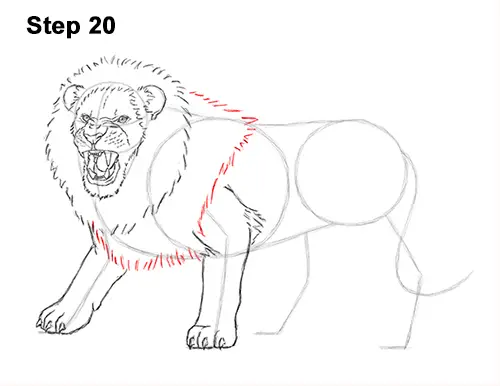
Step 20: Draw the rest of the lion's mane strecthing back toward the body using quick, short strokes. Add the strokes lightly at first as you follow the basic path of the initial guides. When you're happy with the shape of your mane, darken the quick, short strokes.
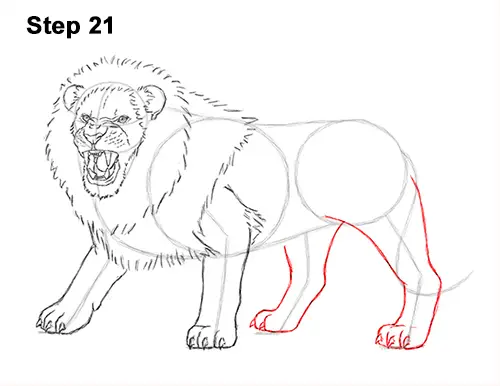
Step 21: Now use the lines on the right as guides to draw the lion's hind legs the same way as the front legs. Sketch the shape of the leg lightly as you follow the guide and only darken the lines when you get the structure right. The lines for the leg should overlap the lines for the tail. The lion's tail will be hidden behind the leg. Draw the toes using a couple of curved lines and add the claws as triangle-like shapes.
Draw the hind leg on the other side of the body using the last line as a guide. The lion's hind legs should be set far aprt as well to give the lion a powerful stance. This foot should have fewer visible toes because of the perspective.
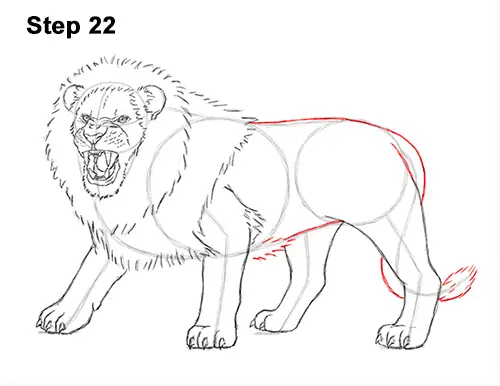
Step 22: Draw the rest of the roaring lion's body using the remaining lines and shapes as guides. Simply follow the outer path of the guides as you darken the lines to create the shape of the body. Most of the tail is hidden behind the hind leg. Add some strokes at the end of the tail for the brush-like tip.
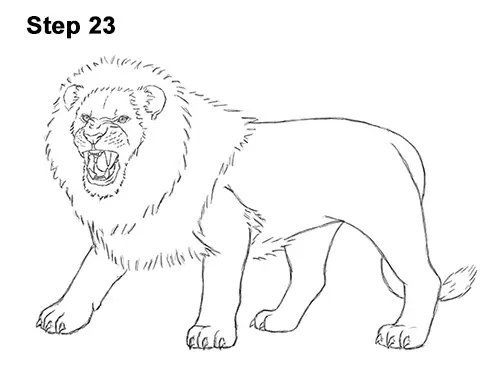
Step 23 (optional): For a cleaner look, erase as much as you can of the initial guide lines. Don't worry about erasing all of guides. It's okay to leave some behind. Re-draw any final sketch lines that you may have accidentally erased.
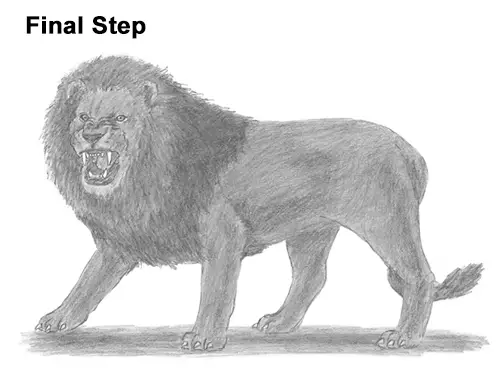
Final Step (optional): Add some shading to your roaring lion drawing to give it more dimension and volume. Pick the direction of the light source when shading so that the shadows are consistent with it. Don't worry too much about the shading if you're going to add more value to your drawing in the final step.
Add a cast shadow underneath. This helps ground the lion so it doesn't appear to be floating.
You can add even more value throughout your roaring lion drawing for extra detail. Add the value lightly at first, then gradually build up to the level of darkness that you want. Vary the pressure on your pencil to get different degrees of tonal value. Use a darker value on the lion's nose, lips and wrinkles to help emphasize them. As you shade the first part of the lion's mane, try to add the value by using strokes that go in the general direction of the mane. In this case, the strokes should radiate outward around the head. Some lions have darker manes, so you can use a darker value if you'd like.
Now shade the second part of the mane using strokes that go back toward the body. Continue shading the second part of the mane using a darker value or the same value as the first part. Add some value to rest of the lion's body, as well. Try to add the value smoothly to the body so that you don't end up with a rough texture. Shading can be time-consuming, so be patient and take breaks. Continue adding the value until the entire body is covered and you achieve the level of darkness that you like. It's always a good idea to use reference for a more accurate drawing. Remember to pause the "How to Draw a Roaring Lion" video after each step to draw at your own pace.
Thanks for watching! Subscribe to the How2DrawAnimals YouTube Channel for a new tutorial every Tuesday.
To learn how to draw popular cartoon characters, visit EasyDrawingTutorials.com.







